Orton C., Tyers P., Vince A. Pottery in archaeology
Подождите немного. Документ загружается.


Collection policy and practice
47
important, when sieving for pottery, to make sure that the mesh size
is
not too
small. Sherds less than 10mm across take a long time to process and identify
and in most quantification methods will make little difference to the overall
statistics of an assemblage. Sherds less than 20mm across might, on the other
hand, be vital if one were trying to reconstruct a decorated fine ware vessel
but would be irrelevant if they came from a storage
jar.
A different approach
is needed when sieving to recover all the pieces of a vessel than when one is
merely ensuring that all sherds over a certain size have been recovered.
In order to assess the results of sieving you will need to keep sherds from
sieving separate from those recovered by hand. On the excavations at Bill-
ingsgate in the City of London, five numbers were assigned to every deposit,
distinguishing: (1) finds recovered during excavation; (2) finds recovered
during metal detecting; (3) finds from coarse water sieving (20mm mesh); (4)
finds from fine water sieving (2mm mesh); and (5) finds from environmental
samples. Ironically, analysis of the pottery from these different recovery
methods showed that (1) and (2) were the most productive in terms of sample
size and range of types present. This is because the sub-sample which was
water sieved was much smaller than those excavated or metal detected and
because the original vessels were rarely smaller than 100mm tall and 150mm
wide. Finally, the method of analysis adopted involved the measurement of
rim-eves (see p. 173) and more of the rim sherds were found by hand. Should
you intend to use sieving to produce a correction factor remember that you
will need to know the total assemblage recovered from a given sample of soil.
If you are also interested in working out recovery rates you will need to
record the potsherds as three groups: (a) found by hand in the sample; (b)
found in the sieve; and (c) found by hand in the rest of the deposit. There are
occasions where the quantity of pottery per unit volume of deposit may be
significant. This is best examined by the sieving of samples of the same size,
c. 30kg for example.
A closely related issue is the use of sampling. What collection policy is
adopted will again depend very much on the use to which the data are to be
put. Whereas a localised sub-sample might well provide an adequate estimate
of the composition of the total assemblage, it will be useless if the main value
of the pottery is to be found in the spatial distribution of pottery on the site.
In the latter case it is better to assume that bias is going to be similar over the
whole site and to record the finds by grid or by 3-D coordinates. The use of
either of these systems will involve the staff in considerable paperwork but
there is no problem in analysing such data by computer. It is always possible
to combine the records from appropriate grid squares to produce a total for a
deposit. The reverse is not true, so it is important to recognise the need for
detailed recording before too much of a deposit has been excavated.
It is often possible to predict which parts of
a
site are likely to contain the
most useful pottery assemblages and it may be necessary to adapt the
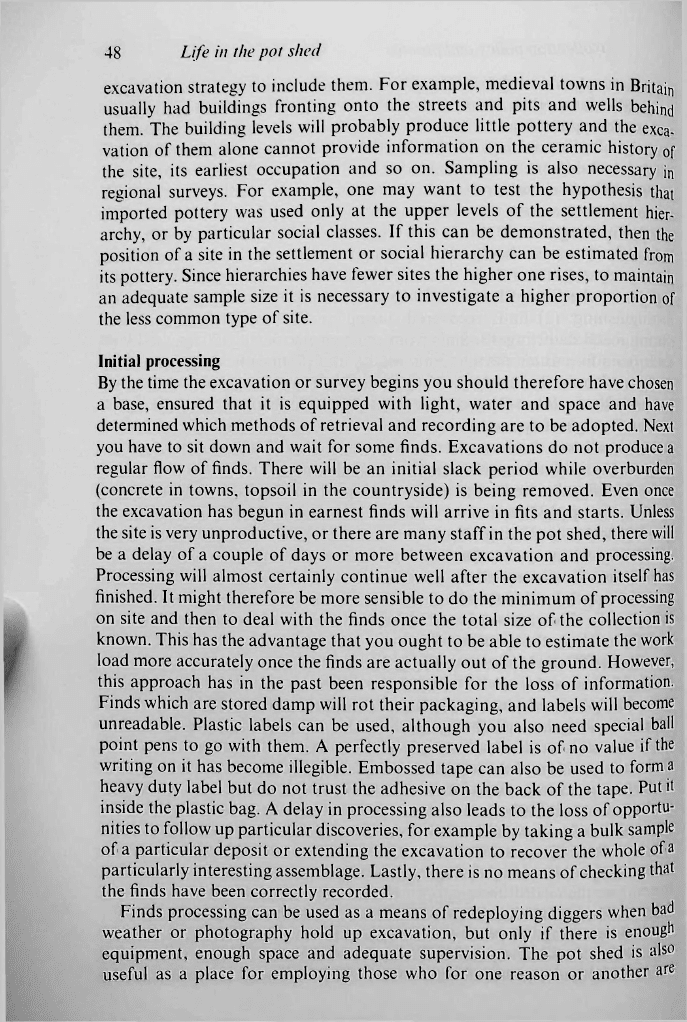
48 Life in the pot shed
excavation strategy to include them. For example, medieval towns in Britain
usually had buildings fronting onto the streets and pits and wells behind
them. The building levels will probably produce little pottery and the exca-
vation of them alone cannot provide information on the ceramic history of
the site, its earliest occupation and so on. Sampling is also necessary in
regional surveys. For example, one may want to test the hypothesis that
imported pottery was used only at the upper levels of the settlement hier-
archy, or by particular social classes. If this can be demonstrated, then the
position of a site in the settlement or social hierarchy can be estimated from
its pottery. Since hierarchies have fewer sites the higher one rises, to maintain
an adequate sample size it is necessary to investigate a higher proportion of
the less common type of site.
Initial processing
By the time the excavation or survey begins you should therefore have chosen
a base, ensured that it is equipped with light, water and space and have
determined which methods of retrieval and recording are to be adopted. Next
you have to sit down and wait for some finds. Excavations do not produce a
regular flow of finds. There will be an initial slack period while overburden
(concrete in towns, topsoil in the countryside) is being removed. Even once
the excavation has begun in earnest finds will arrive in fits and starts. Unless
the site is very unproductive, or there are many staff in the pot shed, there will
be a delay of a couple of days or more between excavation and processing,
Processing will almost certainly continue well after the excavation itself has
finished. It might therefore be more sensible to do the minimum of processing
on site and then to deal with the finds once the total size of the collection is
known. This has the advantage that you ought to be able to estimate the work
load more accurately once the finds are actually out of the ground. However,
this approach has in the past been responsible for the loss of information.
Finds which are stored damp will rot their packaging, and labels will become
unreadable. Plastic labels can be used, although you also need special ball
point pens to go with them. A perfectly preserved label is of no value if the
writing on it has become illegible. Embossed tape can also be used to forma
heavy duty label but do not trust the adhesive on the back of the tape. Put it
inside the plastic bag. A delay in processing also leads to the loss of opportu*
nities to follow up particular discoveries, for example by taking a bulk sample
of a particular deposit or extending the excavation to recover the whole of
a
particularly interesting assemblage. Lastly, there is no means of checking that
the finds have been correctly recorded.
Finds processing can be used as a means of redeploying diggers when bad
weather or photography hold up excavation, but only if there is enough
equipment, enough space and adequate supervision. The pot shed is also
useful as a place for employing those who for one reason or another are

Equipment
49
temporarily unable to dig. Beware, however, that the pot shed is not seen as a
convenient dumping ground for people who have proved themselves incap-
able of
useful
work on site. Work in the pot shed may be less strenuous than
on site but it requires just as precise and conscientious an approach.
Equipment
If your project has easy access to a modern town you can probably find most
of the equipment needed for the pot shed without too much difficulty.
Hardware stores can supply most goods whilst large towns may have a
supplier who can make up plastic bags to your requirements. The range of
materials needed and their quantities can be decided in the first few days of
the dig, or supplies can be topped up as they run low. Large units will have a
central supply of equipment on hand. In developing countries it is both
ethically and socially preferable to purchase as much equipment locally as
possible. It is probably just as easy to spend time in the local bazaar as it is
trying to find out what happened to your supplies at the airport. If you do not
know what will be available locally try to find out before you get there from
someone who knows. If there is a preliminary expedition to the site try to get
on it or give a checklist to someone who is going.
There will be occasions where most of the equipment has to be imported to
the site. With small items, like tooth brushes, mapping pens or Indian ink it is
much better to be over-supplied than to run out. The space required in your
transport to pack bulky items will probably form a limiting factor to the scale
of your operation. If you can envisage something breaking then try to pack a
spare.
Once the dig starts, the first thing you will need is a suitable type of
container to collect finds on site. For hand recovery wooden or plastic seed
trays are good. They should have some means of attaching a label to them,
although most supervisors find it sufficient to weigh the labels down with a
heavy stone or potsherd. Don't write the context on the tray itself because
someone could reuse the tray without noticing the marking. The supervisor
should provide two labels per tray, marked with the site code, the context
number and perhaps his or her name and the date. The second label will be
needed during washing so that one can go with the washed finds and one can
stay with the unwashed, cutting out a potential source of error. If it is
necessary to write out extra labels, for example if a group of finds do not all fit
into one drying tray, they should have all the information listed above, plus
the name (or initials) of the person writing them.
Bulk samples for sieving will need heavy duty containers, such as dustbins.
Very productive deposits, such as those containing pottery waste or vast
quantities of building materials, may require very large trays. Large plastic
crates are suitable, if you can get hold of them. Tea chests, on the other hand,
are too heavy when full and have no handles or grips. If nothing else is
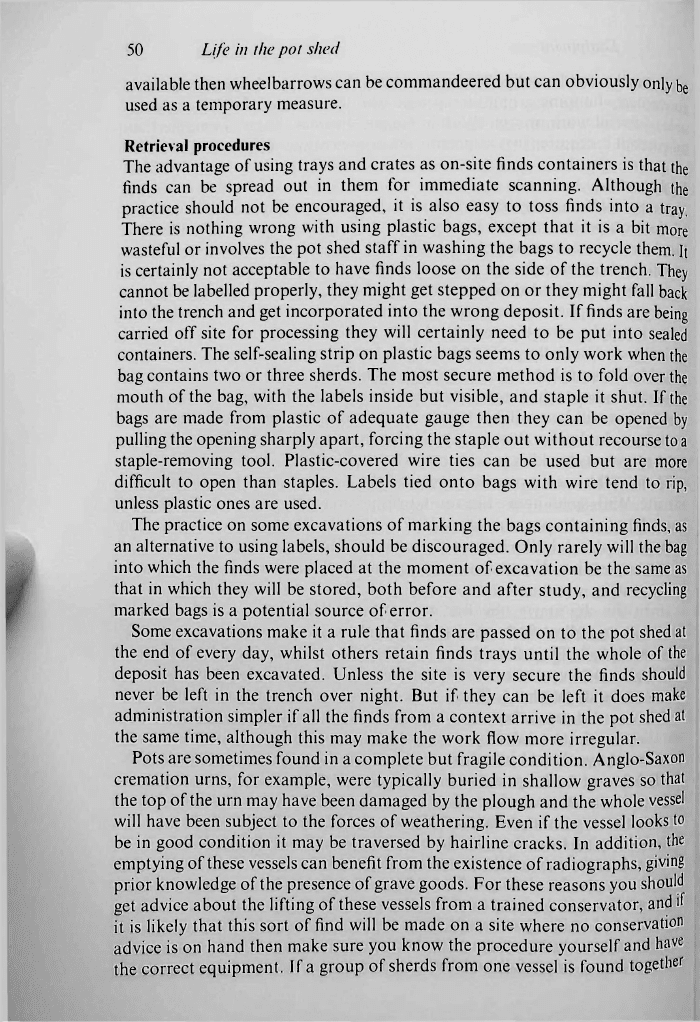
50
Life in the pot shed
available then wheelbarrows can be commandeered but can obviously only b
e
used as a temporary measure.
Retrieval procedures
The advantage of using trays and crates as on-site finds containers is that the
finds can be spread out in them for immediate scanning. Although the
practice should not be encouraged, it is also easy to toss finds into a trayi
There is nothing wrong with using plastic bags, except that it is a bit more
wasteful or involves the pot shed staff in washing the bags to recycle them. It
is certainly not acceptable to have finds loose on the side of the trench. They
cannot be labelled properly, they might get stepped on or they might fall back
into the trench and get incorporated into the wrong deposit. If finds are being
carried off site for processing they will certainly need to be put into sealed
containers. The self-sealing strip on plastic bags seems to only work when the
bag contains two or three sherds. The most secure method is to fold over the
mouth of the bag, with the labels inside but visible, and staple it shut. If
the
bags are made from plastic of adequate gauge then they can be opened by
pulling the opening sharply apart, forcing the staple out without recourse
to a
staple-removing tool. Plastic-covered wire ties can be used but are more
difficult to open than staples. Labels tied onto bags with wire tend to rip,
unless plastic ones are used.
The practice on some excavations of marking the bags containing finds, as
an alternative to using labels, should be discouraged. Only rarely will the bag
into which the finds were placed at the moment of excavation be the same as
that in which they will be stored, both before and after study, and recycling
marked bags is a potential source of error.
Some excavations make it a rule that finds are passed on to the pot shed at
the end of every day, whilst others retain finds trays until the whole of the
deposit has been excavated. Unless the site is very secure the finds should
never be left in the trench over night. But if they can be left it does make
administration simpler if all the finds from a context arrive in the pot shed at
the same time, although this may make the work flow more irregular.
Pots are sometimes found in a complete but fragile condition. Anglo-Saxon
cremation urns, for example, were typically buried in shallow graves so that
the top of the urn may have been damaged by the plough and the whole vessel
will have been subject to the forces of weathering. Even if the vessel looks to
be in good condition it may be traversed by hairline cracks. In addition, the
emptying of these vessels can benefit from the existence of radiographs, giving
prior knowledge of the presence of grave goods. For these reasons you should
get advice about the lifting of these vessels from a trained conservator, and
if
it is likely that this sort of find will be made on a site where no conservation
advice is on hand then make sure you know the procedure yourself and have
the correct equipment. If a group of sherds from one vessel is found together
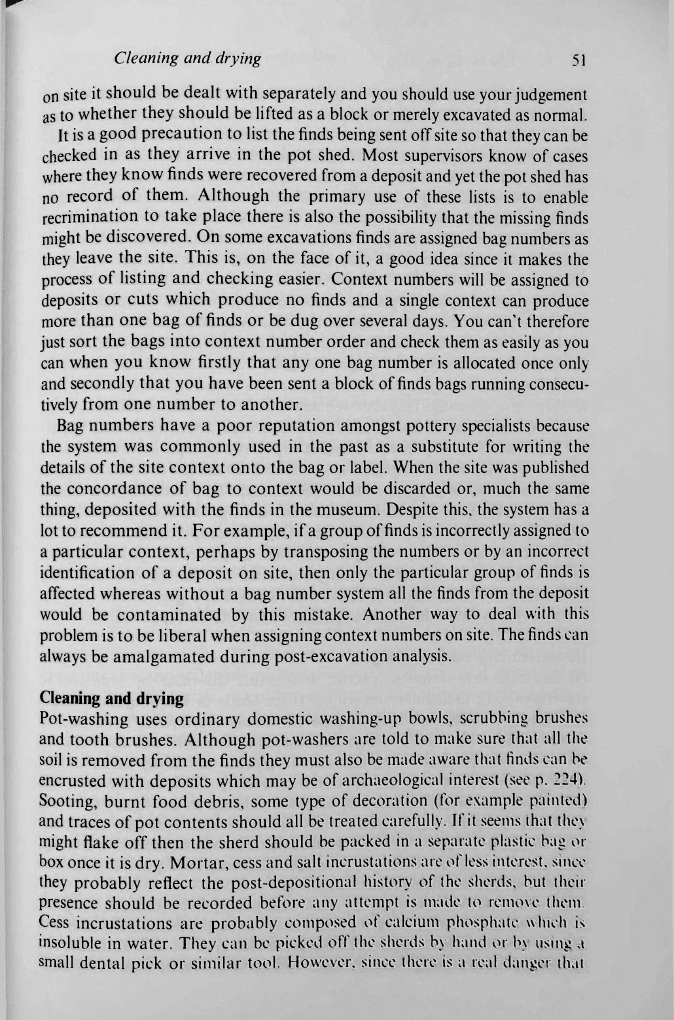
Cleaning and drying
51
on site it should be dealt with separately and you should use your judgement
as to whether they should be lifted as a block or merely excavated as normal.
It is a good precaution to list the finds being sent off site so that they can be
checked in as they arrive in the pot shed. Most supervisors know of cases
where they know finds were recovered from a deposit and yet the pot shed has
no record of them. Although the primary use of these lists is to enable
recrimination to take place there is also the possibility that the missing finds
might be discovered. On some excavations finds are assigned bag numbers as
they leave the site. This is, on the face of it, a good idea since it makes the
process of listing and checking easier. Context numbers will be assigned to
deposits or cuts which produce no finds and a single context can produce
more than one bag of finds or be dug over several days. You can't therefore
just sort the bags into context number order and check them as easily as you
can when you know firstly that any one bag number is allocated once only
and secondly that you have been sent a block of finds bags running consecu-
tively from one number to another.
Bag numbers have a poor reputation amongst pottery specialists because
the system was commonly used in the past as a substitute for writing the
details of the site context onto the bag or label. When the site was published
the concordance of bag to context would be discarded or, much the same
thing, deposited with the finds in the museum. Despite this, the system has a
lot to recommend it. For example, if a group of finds is incorrectly assigned to
a particular context, perhaps by transposing the numbers or by an incorrect
identification of a deposit on site, then only the particular group of finds is
affected whereas without a bag number system all the finds from the deposit
would be contaminated by this mistake. Another way to deal with this
problem is to be liberal when assigning context numbers on site. The finds can
always be amalgamated during post-excavation analysis.
Cleaning and drying
Pot-washing uses ordinary domestic washing-up bowls, scrubbing brushes
and tooth brushes. Although pot-washers are told to make sure that all the
soil is removed from the finds they must also be made aware that
finds
can be
encrusted with deposits which may be of archaeological interest (see p. 224).
Sooting, burnt food debris, some type of decoration (for example painted)
and traces of pot contents should all be treated carefully. If it seems that they
might flake off then the sherd should be packed in a separate plastic bag or
box once it is dry. Mortar, cess and salt incrustations are of less interest, since
they probably reflect the post-depositional history of the sherds, but their
presence should be recorded before any attempt is made to remove them.
Cess incrustations are probably composed of calcium phosphate which is
insoluble in water. They can be picked off the sherds by hand or by using a
small dental pick or similar tool. However, since there is a real danger that

52 Life in the pot shed
glaze or surface coatings will be removed with the cess it is better to leave this
to a conservator. Salt incrustation can be removed by soaking for a long
period in fresh water. If sherds are not treated they will disintegrate as the
salts dry out and crystallise. Water tanks and net bags will be needed for this.
Sieves can be used with a strong water supply to wash the worst of the dirt
off finds before finishing by hand. In certain circumstances, for example when
dealing with production waste where the fabric is known and no reconstruc-
tion of vessels is to be attempted, there may be no need to wash all the
finds
manually. Use of a hose on this scale will, however, create a problem of water
disposal.
Drying can take place in plastic or wooden trays but will be quicker if the
sherds are placed on mesh-bottomed trays which can be stacked in racks. The
mesh should ideally be smaller than the smallest finds, although this system
can be used with sheets of newspaper lining the trays. Animal bone should
be
dried slowly and evenly so as to minimise stresses in the bone which may lead
to warping or cracking. This may well determine the way in which your
finds
are dried but potsherds can be dried much more quickly without any appar-
ent ill effects. You may therefore find it expedient to separate animal bone
from other finds at this stage and have an area set aside for them to dry at
their own rate while you place the potsherds and other finds in the warmest
areas you can find. Thick sherds contain a large amount of moisture,
especially if they have a porous texture. Organic-tempered sherds must be
dried thoroughly or they will grow moulds. If placed in paper bags or
cardboard boxes in this condition they can cause rot. At the very least they
will need to be re-washed once post-excavation work gets under way. At
worst they may cause the whole collection to have to be repacked.
Initial recording and processing
At this stage it is common practice to separate the finds by type and to
undertake some preliminary recording. If the study of building materials is
well enough advanced it may be possible to use a reference collection to
identify materials, count or weigh the fragments, or both, and then discard
them. However, hearth-lining and kiln fragments are easily mistaken for
daub or mud brick and it is preferable to keep all materials until the
post-excavation stage, so that they can be examined in the light of the site
stratigraphy. Examining the whole collection at the same time may also
make
evident trends and patterns which would otherwise be overlooked. Certainly,
no finds should be discarded until the specialist who is to publish them has
had a chance to examine them.
In some circumstances the range of materials likely to be found in a deposit
is well enough known for a pre-printed sheet to be produced on which you
merely have to tick the presence of a particular type of find and note the
quantity present in rough terms. These 'bulk records' can be used as the basis

Initial recording and processing
53
for costing and planning post-excavation and publication work and can be
made even more useful by including a reference to the storage location of the
finds, for example a box number. In the long run it is better to plan this in
conjunction with the museum or resource centre where the finds will ulti-
mately be stored, but in practice there are many reasons why this may not be
possible. To give just two: (i) you may be boxing classes of finds which will
eventually be discarded, leaving gaps in the number sequence; and (ii) there
maybe good reasons why you want to have a
different
type of storage during
post-excavation work (when finds may well be moved over long distances
several times) and their eventual storage, where they may only be moved
within the building. If the finds are stored in separate boxes for each material
it will be simpler later on to extract a class of finds for study. The 'bulk
record' will act as an index to which boxes are required. It is also easier to
estimate the length of time needed for analysis if finds are always stored in
standard-sized boxes.
Once the finds are separated into their materials and classes, the pottery
and other ceramics can be marked in Indian ink using a mapping pen. Never
use a technical drawing pen to mark pot, and always get new pot markers to
practice on bits of discarded tile before setting them loose on important finds.
Marking is absolutely essential if there is any chance that finds from more
than one context will be laid out for study together. Everyone has momentary
lapses when they find it impossible to remember where they picked up a
sherd. If it is clear that all the sherds in a deposit are from the same vessel it is
tempting not to mark any of them, or to mark them only on the edges. In this
way the vessel can be reconstructed for display without having unsightly
markings all over it. However, do beware of sending vessels in this state to
conservation laboratories. You may end up with a displayable but archae-
ologically worthless pot. The answer to this problem is to think ahead and
make sure that the underside of the base of the vessel is marked, since this will
probably be unobtrusive when the vessel is restored. If the vessel is a hollow
form it is possible to mark the inside of the sherds in such a way that the
marking can be seen if necessary but will be invisible once the pot is on
display. Quite often you will find parts of what seem to be the same vessel in
more than one deposit. The fact that you are actually dealing with two or
more vessels may only become apparent during conservation. You will also
find odd sherds from other vessels with the sherds of a shattered cremation
urn. This emphasises the need to mark every sherd with both site code and
context number except in very unusual circumstances.
Over the years, many people have thought of ways in which you could take
the
effort
and boredom out of marking pottery. Indeed, the very nature of the
task leads you quickly to that line of thought. Rubber stamps have been tried
and, surprisingly considering the rough surfaces of most potsherds, the
impression quite often comes out successfully. However, the ink supplied
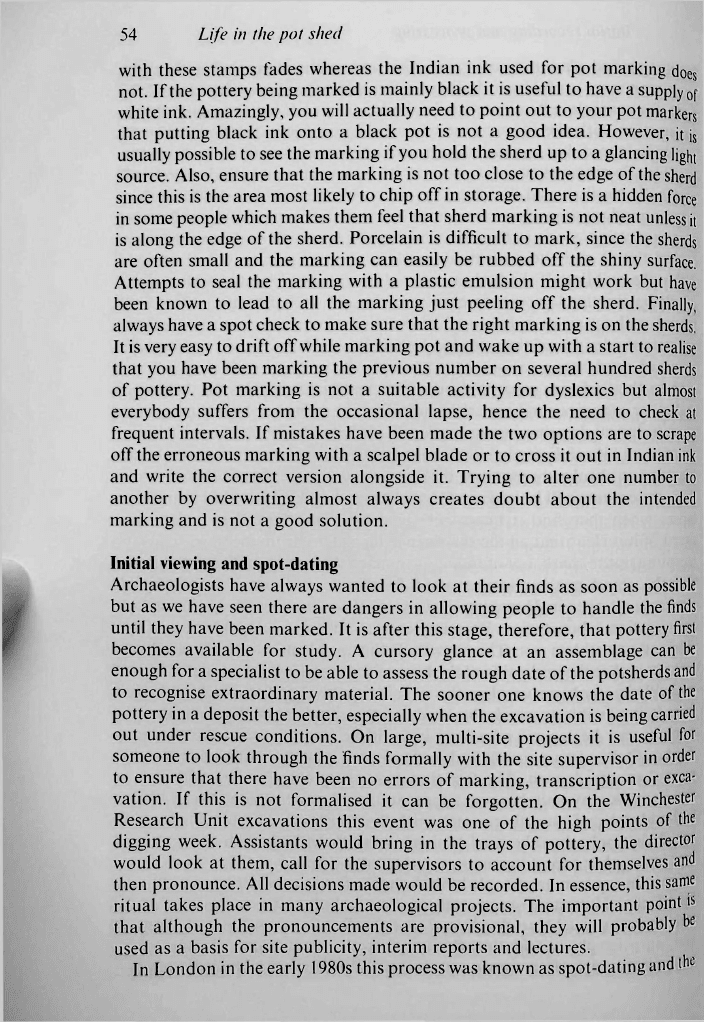
54 Life in the pot shed
with these stamps fades whereas the Indian ink used for pot marking does
not. If the pottery being marked is mainly black it is useful to have a supply
of
white ink. Amazingly, you will actually need to point out to your pot markers
that putting black ink onto a black pot is not a good idea. However, it i
s
usually possible to see the marking if you hold the sherd up to a glancing light
source. Also, ensure that the marking is not too close to the edge of the sherd
since this is the area most likely to chip off in storage. There is a hidden force
in some people which makes them feel that sherd marking is not neat unless it
is along the edge of the sherd. Porcelain is difficult to mark, since the sherds
are often small and the marking can easily be rubbed off the shiny surface
Attempts to seal the marking with a plastic emulsion might work but have
been known to lead to all the marking just peeling off the sherd. Finally,
always have a spot check to make sure that the right marking is on the sherds,
It is very easy to drift off while marking pot and wake up with a start to realise
that you have been marking the previous number on several hundred sherds
of pottery. Pot marking is not a suitable activity for dyslexics but almost
everybody suffers from the occasional lapse, hence the need to check at
frequent intervals. If mistakes have been made the two options are to scrape
off the erroneous marking with a scalpel blade or to cross it out in Indian ink
and write the correct version alongside it. Trying to alter one number to
another by overwriting almost always creates doubt about the intended
marking and is not a good solution.
Initial viewing and spot-dating
Archaeologists have always wanted to look at their finds as soon as possible
but as we have seen there are dangers in allowing people to handle the finds
until they have been marked. It is after this stage, therefore, that pottery
first
becomes available for study. A cursory glance at an assemblage can be
enough for a specialist to be able to assess the rough date of the potsherds
and
to recognise extraordinary material. The sooner one knows the date of the
pottery in a deposit the better, especially when the excavation is being carried
out under rescue conditions. On large, multi-site projects it is useful for
someone to look through the finds formally with the site supervisor in order
to ensure that there have been no errors of marking, transcription or exca-
vation. If this is not formalised it can be forgotten. On the Winchester
Research Unit excavations this event was one of the high points of the
digging week. Assistants would bring in the trays of pottery, the director
would look at them, call for the supervisors to account for themselves and
then pronounce. All decisions made would be recorded. In essence, this same
ritual takes place in many archaeological projects. The important point is
that although the pronouncements are provisional, they will probably be
used as a basis for site publicity, interim reports and lectures.
In London in the early 1980s this process was known as spot-dating and the
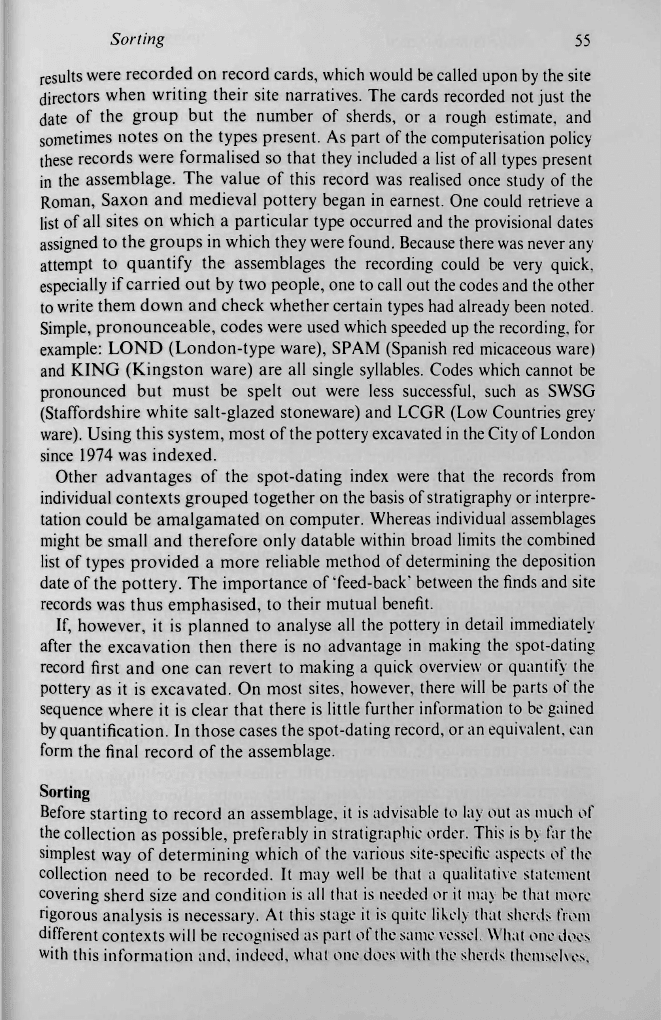
Sorting
55
results were recorded on record cards, which would be called upon by the site
directors when writing their site narratives. The cards recorded not just the
date of the group but the number of sherds, or a rough estimate, and
sometimes notes on the types present. As part of the computerisation policy
these records were formalised so that they included a list of all types present
in the assemblage. The value of this record was realised once study of the
Roman, Saxon and medieval pottery began in earnest. One could retrieve a
list of all sites on which a particular type occurred and the provisional dates
assigned to the groups in which they were found. Because there was never any
attempt to quantify the assemblages the recording could be very quick,
especially if carried out by two people, one to call out the codes and the other
to write them down and check whether certain types had already been noted.
Simple, pronounceable, codes were used which speeded up the recording, for
example: LOND (London-type ware), SPAM (Spanish red micaceous ware)
and KING (Kingston ware) are all single syllables. Codes which cannot be
pronounced but must be spelt out were less successful, such as SWSG
(Staffordshire white salt-glazed stoneware) and LCGR (Low Countries grey
ware). Using this system, most of the pottery excavated in the City of London
since 1974 was indexed.
Other advantages of the spot-dating index were that the records from
individual contexts grouped together on the basis of stratigraphy or interpre-
tation could be amalgamated on computer. Whereas individual assemblages
might be small and therefore only datable within broad limits the combined
list of types provided a more reliable method of determining the deposition
date of the pottery. The importance of 'feed-back' between the finds and site
records was thus emphasised, to their mutual benefit.
If, however, it is planned to analyse all the pottery in detail immediately
after the excavation then there is no advantage in making the spot-dating
record first and one can revert to making a quick overview or quantify the
pottery as it is excavated. On most sites, however, there will be parts of the
sequence where it is clear that there is little further information to be gained
by quantification. In those cases the spot-dating record, or an equivalent, can
form the final record of the assemblage.
Sorting
Before starting to record an assemblage, it is advisable to lay out as much of
the collection as possible, preferably in stratigraphic order. This is by far the
simplest way of determining which of the various site-specific aspects of the
collection need to be recorded. It may well be that a qualitative statement
covering sherd size and condition is all that is needed or it may be that more
rigorous analysis is necessary. At this stage it is quite likely that sherds from
different contexts will be recognised as part of the same vessel. What one does
with this information and, indeed, what one does with the sherds themselves.
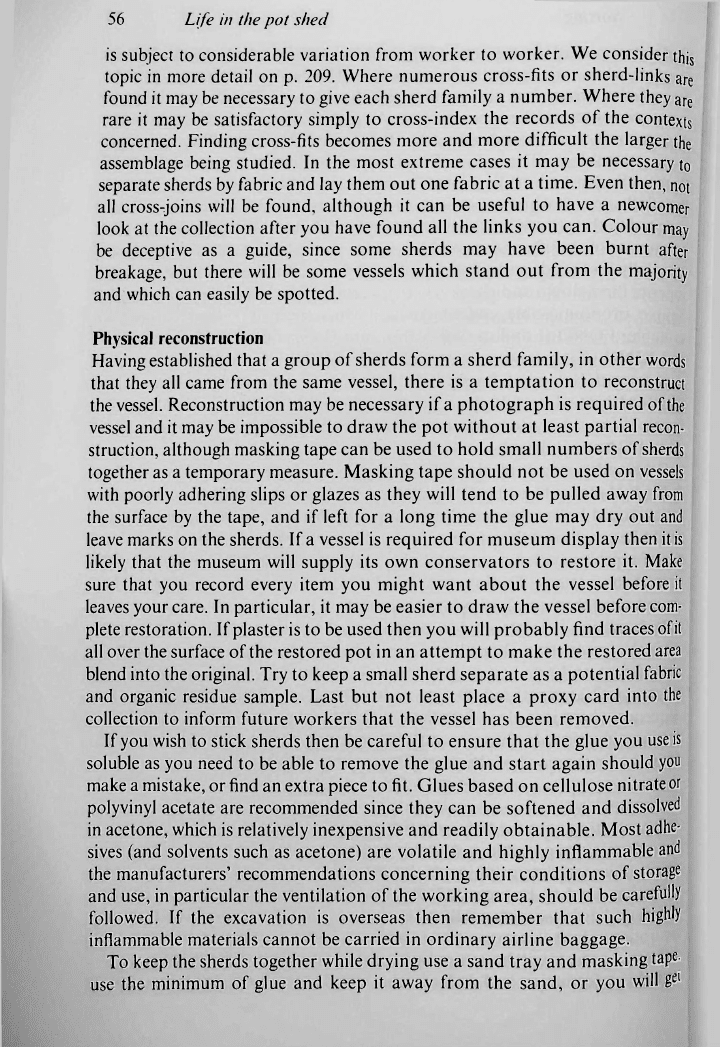
56 Life in the pot shed
is subject to considerable variation from worker to worker. We consider this
topic in more detail on p. 209. Where numerous cross-fits or sherd-links are
found it may be necessary to give each sherd family a number. Where they are
rare it may be satisfactory simply to cross-index the records of the contexts
concerned. Finding cross-fits becomes more and more difficult the larger the
assemblage being studied. In the most extreme cases it may be necessary to
separate sherds by fabric and lay them out one fabric at a time. Even then, not
all cross-joins will be found, although it can be useful to have a newcomer
look at the collection after you have found all the links you can. Colour may
be deceptive as a guide, since some sherds may have been burnt after
breakage, but there will be some vessels which stand out from the majority
and which can easily be spotted.
Physical reconstruction
Having established that a group of sherds form a sherd family, in other words
that they all came from the same vessel, there is a temptation to reconstruct
the vessel. Reconstruction may be necessary if a photograph is required of the
vessel and it may be impossible to draw the pot without at least partial recon- i
struction, although masking tape can be used to hold small numbers of sherds j
together as a temporary measure. Masking tape should not be used on vessels
with poorly adhering slips or glazes as they will tend to be pulled away from !
the surface by the tape, and if left for a long time the glue may dry out and ;
leave marks on the sherds. If a vessel is required for museum display then it
is
[
likely that the museum will supply its own conservators to restore it. Make j
sure that you record every item you might want about the vessel before it [;
leaves your care. In particular, it may be easier to draw the vessel before com- ;
plete restoration. If plaster is to be used then you will probably find traces ofit
y
all over the surface of the restored pot in an attempt to make the restored area
blend into the original. Try to keep a small sherd separate as a potential fabric j
and organic residue sample. Last but not least place a proxy card into the I
collection to inform future workers that the vessel has been removed.
If you wish to stick sherds then be careful to ensure that the glue you use
is
I
soluble as you need to be able to remove the glue and start again should you j
make a mistake, or find an extra piece to fit. Glues based on cellulose nitrate
or
j
polyvinyl acetate are recommended since they can be softened and dissolved
in acetone, which is relatively inexpensive and readily obtainable. Most adhe-
sives (and solvents such as acetone) are volatile and highly inflammable and
the manufacturers' recommendations concerning their conditions of storage
and use, in particular the ventilation of the working area, should be carefully
(
followed. If the excavation is overseas then remember that such highly,
inflammable materials cannot be carried in ordinary airline baggage.
To keep the sherds together while drying use a sand tray and masking tape- !
use the minimum of glue and keep it away from the sand, or you will Jp
